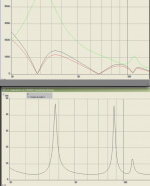Also with a cabinet of this size, I'm sure you're planning on installing casters, correct? Or are you going to rely on Dolly's and hand trucks for transportation?
I have a PDF a solidworks model and print and Auticad prints. I've probably sent them to 20 people already. Originally the plan was to cnc a flat kit so that is how the model and print is setup.
There is room for casters and handles in the cab.
There is room for casters and handles in the cab.
Apparently the cab without the driver in weighs in at 132lbs so that will be about 180 all buttoned up with the driver. A little heavier than I expected but I guess I shouldn't be surprised since it is a 36x36x24" horn cab.
Send me your email address.
I'd also love to take a look at it!
Send me your email address.
Hellooooo . . .
What happened, a family of Baltic Beavers come to reclaim the family homestead???
What happened, a family of Baltic Beavers come to reclaim the family homestead???
Hellooooo . . .
What happened, a family of Baltic Beavers come to reclaim the family homestead???
+1
I guess so....Haven't heard anything in a week or 2. I think they are waiting on the Duratex and Beaver Buster 9000 to come in.
I finally have my pair of cabs. Once again the cabinet shop has done a remarkable job with them. These have been coated with Duratex, are very solid and should support the weight of a truck with no problem. I still have to think about what hardware I'm going to use on them. I have mounted one of the 21's and checked an 18" with the adaptor plate and both mount up perfectly.
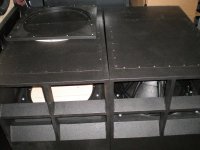
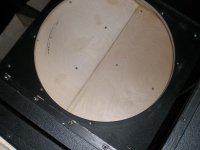
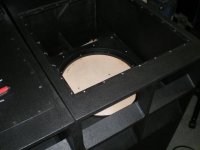

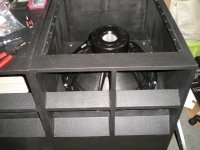
Here are a few more pics showing the adaptor plates for 18" drivers. These bolt onto the existing baffle and fit down into the 21" driver cutout. The plate bolts into the holes for mounting the 21" driver plus a few extras.
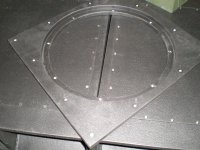
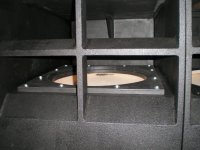
Unfortunately I have not had a chance to actually do much with them yet. Hopefully I will get a chance soon. All I have so far is one driver mounted and a very quick close mic response measurement in room and no damping in the cab. Overall it is shaped a little different than the simulation but is fairly smooth up to 250Hz (For a TH ). There is a bit of a dip at 90Hz. As usual the actual corner is a little lower than the simulation. Driver excursion minimum occurs at 28Hz so 25Hz extension should be well met. The SPL level in the measurement is uncalibrated and at an arbitrary level. I am not sure what is causing the small notch at 42Hz. I haven't had a chance to think about it too much yet. The waterfall also shows that there is some sort of a issue at 42Hz and an odd one with output decaying rapidly for the first 20dB but then ringing a little at that point. Perhaps reflected energy from the backside of the driver? Other than that the decay rate is remarkably clean for a horn with very rapid loss of energy. In particular I expected there to be a notable ring at 108Hz and a couple of the other response spikes which is usual with other high Q response features, but instead the energy drops 30dB very rapidly. I suspect that after developing EQ to flatten the response above 100Hz and the addition of some damping in the enclosure that this will improve even further. I have access to the throat, 1st corner, last 2 corners and mouth, so I will try adding some damping in these places when I have a chance. An actual outdoor quasi-anechoic response measurement might show slightly different response features than the extreme close mic also.
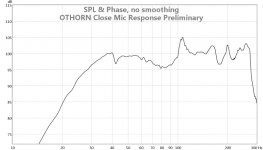
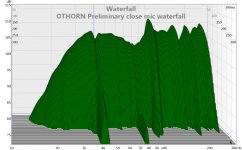






Here are a few more pics showing the adaptor plates for 18" drivers. These bolt onto the existing baffle and fit down into the 21" driver cutout. The plate bolts into the holes for mounting the 21" driver plus a few extras.


Unfortunately I have not had a chance to actually do much with them yet. Hopefully I will get a chance soon. All I have so far is one driver mounted and a very quick close mic response measurement in room and no damping in the cab. Overall it is shaped a little different than the simulation but is fairly smooth up to 250Hz (For a TH ). There is a bit of a dip at 90Hz. As usual the actual corner is a little lower than the simulation. Driver excursion minimum occurs at 28Hz so 25Hz extension should be well met. The SPL level in the measurement is uncalibrated and at an arbitrary level. I am not sure what is causing the small notch at 42Hz. I haven't had a chance to think about it too much yet. The waterfall also shows that there is some sort of a issue at 42Hz and an odd one with output decaying rapidly for the first 20dB but then ringing a little at that point. Perhaps reflected energy from the backside of the driver? Other than that the decay rate is remarkably clean for a horn with very rapid loss of energy. In particular I expected there to be a notable ring at 108Hz and a couple of the other response spikes which is usual with other high Q response features, but instead the energy drops 30dB very rapidly. I suspect that after developing EQ to flatten the response above 100Hz and the addition of some damping in the enclosure that this will improve even further. I have access to the throat, 1st corner, last 2 corners and mouth, so I will try adding some damping in these places when I have a chance. An actual outdoor quasi-anechoic response measurement might show slightly different response features than the extreme close mic also.



Looks good, Josh!Overall it is shaped a little different than the simulation but is fairly smooth up to 250Hz (For a TH ). There is a bit of a dip at 90Hz. As usual the actual corner is a little lower than the simulation.
An actual outdoor quasi-anechoic response measurement might show slightly different response features than the extreme close mic also.
Seems the Othorn has a 4 dB 90 Hz dip while the sim predicts about +1 dB there, a fairly large difference.
Be interesting to see what the outdoor measurements are like, I suspect they will be a bit closer to the sim.
The low corner is a couple Hz higher, the rolloff less rapid, only about 12 dB per octave, remarkable for a TH.
Your Akaback excursion minima looks like 28 Hz, Hornresp about 29, why do you say “As usual the actual corner is a little lower than the simulation”?
Did you try any different mouth measurement positions?
Art
Attachments
You know Art at first I thought that the peaks came in a little lower in frequency but they seem to have lined up pretty close. That's what I get for going from memory. I'm not going to make any judgements until I have a chance to put some damping in and get some measurements at distance outside. I suspect that the difference in response shape is due to errors in modeling of the throat area of the horn. Adding extra Vtc to the sim seems to bring it into closer correspondance. I'm interested to see what the actual sensitivity and useful output turns out to be.
I haven't messed with any different mouth measurements its not really worth messing with it. The outdor result will show what is what. Interestingly if the mouth was placed on the side instead it would end up with a very slightly higher corner but the mouth would be a longer quasi keystone shape.
The actual corner is not any lower it's just that it is less sharp and the shape is different below 80hz. I've seen this in a lot of horn measurements. The knee seems to be less defined compared to the sims for some reason.
I haven't messed with any different mouth measurements its not really worth messing with it. The outdor result will show what is what. Interestingly if the mouth was placed on the side instead it would end up with a very slightly higher corner but the mouth would be a longer quasi keystone shape.
The actual corner is not any lower it's just that it is less sharp and the shape is different below 80hz. I've seen this in a lot of horn measurements. The knee seems to be less defined compared to the sims for some reason.
Last edited:
The Keystone only has about 450 degrees of bends total, it came out with a sharper roll off than the sim.I haven't messed with any different mouth measurements its not really worth messing with it. The outdor result will show what is what. Interestingly if the mouth was placed on the side instead it would end up with a very slightly higher corner but the mouth would be a longer quasi keystone shape.
The actual corner is not any lower it's just that it is less sharp and the shape is different below 80hz. I've seen this in a lot of horn measurements. The knee seems to be less defined compared to the sims for some reason.
Seems the Othorn (about 720 degrees of bends) and similar "bendy" TH like the DSL TH-115, 118, xoc1 TH-18 also share a more gradual roll off.
I'd agree trying more mouth measurements is not worth messing with, but the FR shape can vary quite a bit across the mouth, I would not be surprised if you could not find a different place in the mouth that would match the sim much more closely ;^).
The actual corner is not any lower it's just that it is less sharp and the shape is different below 80hz. I've seen this in a lot of horn measurements. The knee seems to be less defined compared to the sims for some reason.
Could be a leak. Or some sort of internal resonance.
I suggest running an impedance response test on it and compare to the HornResp sim.
Brian impedance measurements and much more will be coming later...Might be awhile though. There are no leaks, Im positive of that.
imp. curve is the best way to compare with the sym.
in my symetric th , i found that the path lenght was of in the mouth section.
at least now i know how to aproach it right.
i have one suggestion,i'd make a brace on the lid .
other than that, it seems like its a nice solid th horn you made.🙂
in my symetric th , i found that the path lenght was of in the mouth section.
at least now i know how to aproach it right.
i have one suggestion,i'd make a brace on the lid .
other than that, it seems like its a nice solid th horn you made.🙂
Josh already measured driver excursion minimum to occur at 28 Hz wich matches the Akaback sim.imp. curve is the best way to compare with the sym.
in my symetric th , i found that the path lenght was of in the mouth section.
at least now i know how to aproach it right.
i have one suggestion,i'd make a brace on the lid .
other than that, it seems like its a nice solid th horn you made.🙂
The driver excursion curve sharply defines the LF, the impedance curve peaks are perhaps easier to read in the excursion maxima areas, but either can give you the information needed to tell if the cabinet is performing like the sim.
I find excursion more important than impedance.
Attachments
- Home
- Loudspeakers
- Subwoofers
- The Othorn tapped horn

